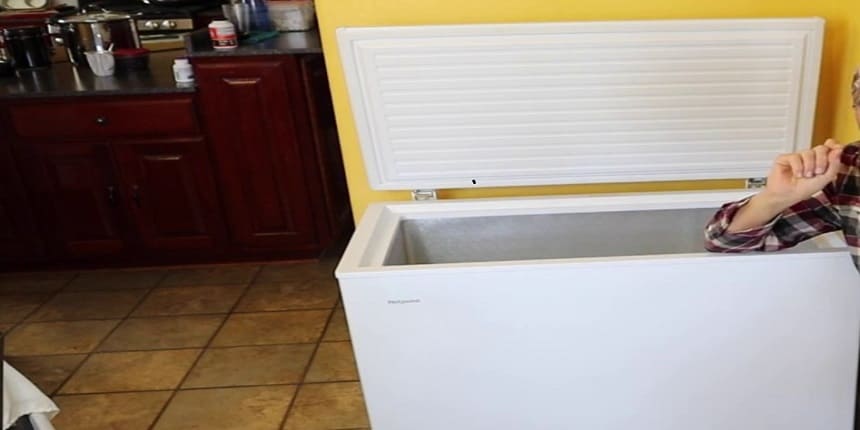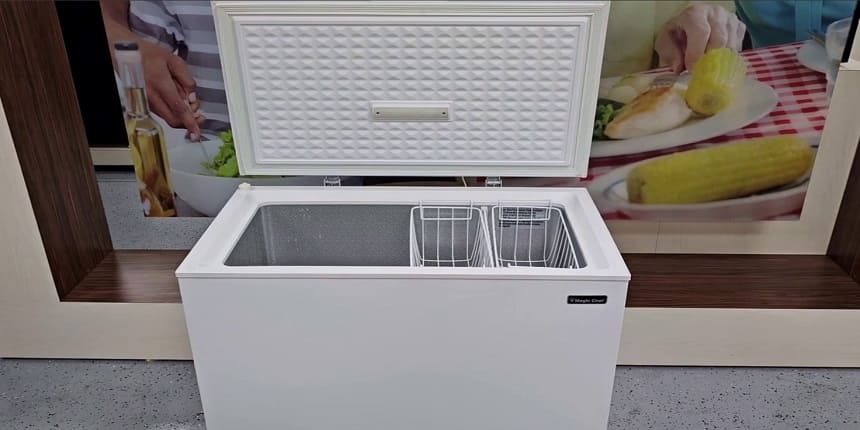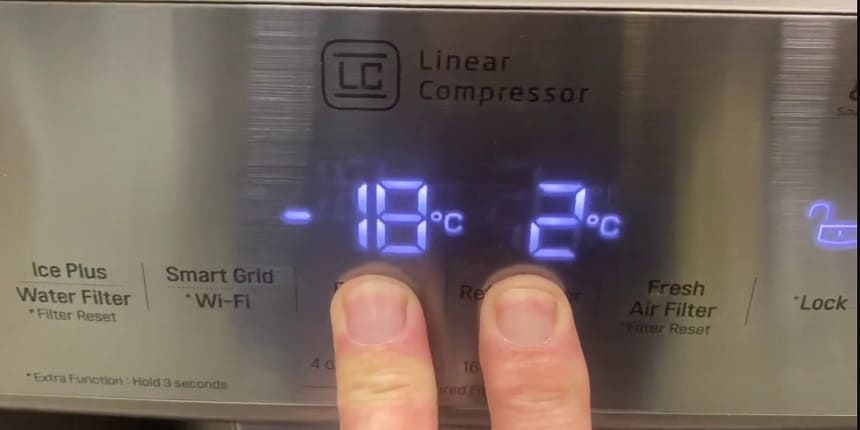A chest freezer only freezing at the bottom may be caused by a malfunctioning or blocked evaporator fan. This can disrupt the circulation of cold air within the freezer, resulting in uneven freezing temperatures.
To address this issue, it’s essential to
First, unplug the freezer and carefully inspect the evaporator fan for any obstructions or signs of damage.
Clearing any debris and ensuring proper fan operation should help restore uniform freezing throughout the appliance.
We will explore common reasons for this problem and provide practical solutions to help rectify the situation and prevent further issues with your chest freezer’s freezing capabilities.
Why is My Chest Freezer Only Freezing At The Bottom – The chest freezer not freezing properly

#1. Poor Air Circulation
One possible reason for a chest freezer only freezing at the bottom could be poor air circulation.
Inadequate placement of food inside the chest freezer can block or obstruct air vents, preventing proper airflow. This can lead to uneven cooling, with the bottom portion of the freezer experiencing the most cooling while the top remains warmer.
Solution: To ensure proper air circulation, it is important to arrange the food items in a way that allows air to circulate freely throughout the freezer.
Avoid overcrowding the freezer and leave space between the items for air to flow. It is also advisable to periodically rearrange the items to prevent any blockage of the vents.
Regularly cleaning the freezer and removing any ice buildup can also help improve air circulation. Ice buildup can restrict airflow and cause the freezer to only freeze at the bottom.
#2. Temperature Imbalance
When a chest freezer is only freezing at the bottom, it may indicate a temperature imbalance within the unit.
Factors such as:
- Poor air circulation
- Overloading
- A faulty thermostat
These can impact the distribution of cold air, leading to uneven freezing.
External influences, such as ambient temperature and placement of the freezer, can also affect its performance.
Solution: To address this problem, it’s important to assess the internal organization of the freezer, ensuring adequate airflow throughout the compartment.
Additionally, monitoring the surrounding environment and maintaining proper ventilation around the appliance can help mitigate temperature inconsistencies.
#3. Incorrect Temperature Settings
When it comes to chest freezers, maintaining the optimal temperature range is crucial for efficient freezing.
Adjusting and calibrating the temperature settings can ensure even cooling throughout the appliance. If the freezer is only freezing at the bottom, it may indicate that the temperature settings are incorrect.
By setting the temperature within the recommended range, you can prevent uneven freezing and ensure food safety.
Make sure to regularly monitor and adjust the settings as needed to maintain consistent freezing performance.
How To Fix Chest Freezer Only Freezing at Bottom – why is my freezer only freezing at the bottom

Fix #1: Organizing Your Freezer For Even Freezing
The proper organization of your freezer plays a crucial role in ensuring even freezing throughout. By arranging your food items strategically, you can avoid the issue of a chest freezer only freezing at the bottom.
Utilizing storage containers and dividers can help you achieve improved organization and prevent uneven freezing.
When organizing your freezer, it is important to consider the placement of different food items.
For example, it is advisable to keep meat products on the bottom shelves to prevent any potential cross-contamination.
Additionally, placing smaller items or produce in the freezer door can help optimize space and ensure better airflow circulation.
- Using storage containers can further enhance organization within your freezer.
- Labeling them with the date and contents can help you keep track and prevent any items from being forgotten.
- Dividers can also be useful to separate different types of food and ensure equal distribution of cold air.
Freezing Techniques For Different Food Types
#1. When freezing fruits, ensure that they are washed and completely dried before placing them in an airtight container or freezer bag.
Additionally, labeling the packaging with the date and contents can aid in maintaining organization and ensuring that food is used in a timely manner.
#2. Blanching vegetables before freezing can help preserve their texture and flavor.
#3. When freezing meats, wrap them tightly in moisture-proof and airtight packaging to prevent freezer burn.
#4. Seafood should be properly cleaned and frozen in suitable containers to maintain its quality.
Fix #2: Ensuring Sufficient Airflow
When a chest freezer is only freezing at the bottom, one possible cause could be insufficient airflow. To ensure proper circulation of air within the freezer, it is important to follow a few guidelines:
Proper placement of food items:
Arrange the food items in a way that allows air to circulate freely. Avoid blocking the air vents and do not overcrowd the freezer.
Managing and maintaining air vents:
Regularly check and clean the air vents to prevent any blockages. Clear away any ice or debris that might accumulate around the vents.
Optimal performance:
Make sure the freezer is placed in a well-ventilated area with sufficient space around it. Avoid positioning it near heat sources or in direct sunlight.
Fix #3: Temperature Calibration And Maintenance
A common issue with chest freezers is when they only freeze at the bottom.
To address this problem,
It is important to regularly monitor and adjust the temperature settings. Keeping an eye on the temperature will help ensure consistent and efficient freezing throughout the freezer.
Regular defrosting and cleaning procedures are crucial for maintaining optimal performance. Defrosting helps remove any ice buildup that may be affecting the freezing capability.
Cleaning the interior of the freezer helps prevent any blockages or buildup that could interfere with the circulation of cold air.
To maintain a well-functioning chest freezer, it is essential to prioritize temperature calibration and perform regular maintenance tasks such as defrosting and cleaning.

Utilizing Temperature Zones
Defining and creating temperature zones for specific food groups can help ensure optimal freezing results throughout the freezer.
When organizing your freezer, it is important to keep in mind that colder temperatures are usually found at the bottom of the unit.
Therefore, it is best to store items that require lower freezing temperatures in this area. This includes items like ice cream, frozen desserts, and meats.
In the middle section of the freezer, where temperatures may be slightly higher, you can store ready-to-eat meals, frozen fruits and vegetables, and other items that don’t require the coldest temperatures for preservation.
Lastly, the top section of the chest freezer, where the temperatures are typically the warmest, can be used for items that require less freezing time or have a shorter shelf life, such as bread, pastries, or items you frequently access.
chest freezer troubleshooting for freezing at the bottom – Chest freezer only freezing at bottom Samsung / Frigidaire
Step 1. Identifying And Correcting Airflow Blockages
Air vents that are blocked or obstructed can disrupt the circulation of cold air, leading to uneven freezing patterns.
There are several common causes of blocked air vents in a chest freezer.
Accumulated ice or frost, food packages placed too close to the vents, or incorrect placement of items can all restrict airflow. To resolve this issue, start by defrosting the freezer to remove any ice or frost build-up.
Once defrosted, ensure that the vents are clear and unobstructed. Avoid overloading the freezer and leave enough space around the vents for proper air circulation.
Organizing the items in the freezer in a way that allows air to flow freely can also help prevent airflow blockages.
Step 2. Temperature Adjustments For Improved Chest Freezer Not Freezing

Troubleshooting temperature fluctuations and variations in freezing in your chest freezer are crucial to ensure consistent performance.
#1: Recalibrating temperature settings can help achieve even freezing throughout the freezer.
To begin, check the temperature control dial on your freezer to ensure it is set to the appropriate level. It is often located within the freezer or at the back of the unit.
Adjusting the dial towards a colder setting can enhance freezing efficiency.
If your freezer has a digital display panel, refer to the manufacturer’s instructions for temperature adjustment. This allows you to set the precise temperature according to your requirements.
#2: Inspect the freezer door seals to ensure they are intact and airtight.
Gaps or cracks in the seals can lead to temperature inconsistencies. Clean the door seals regularly using mild soap and water to maintain their effectiveness.
It is recommended to avoid overloading the freezer, as overcrowding can affect airflow and the ability to maintain low temperatures. Organize food items efficiently to allow for better air circulation.
#3: Regular defrosting is essential to prevent ice buildup, which can impact the freezer’s performance. Follow the manufacturer’s instructions on defrosting frequency and methods.
| Temperature Adjustment Tips | Effects of Incorrect Temperature |
|---|---|
| Set the temperature control dial to a colder setting | Promotes improved freezing |
| Refer to digital display panel for precise temperature adjustment | Allows customization of freezing temperature |
| Ensure freezer door seals are intact and airtight | Prevents temperature fluctuations |
| Avoid overloading the freezer | Enhances airflow and cooling |
| Regularly defrost the freezer | Prevents ice buildup and maintains performance |
Step 3. Maintaining And Cleaning Your Chest Freezer

Regular maintenance tasks are crucial to ensure the proper operation of your chest freezer. Keeping it clean is also essential for preventing odors and promoting optimal freezing. Here are some cleaning techniques and maintenance tips to help you maintain your chest freezer:
- Regularly defrost your freezer to prevent ice buildup, which can affect its efficiency.
- Remove any expired or unwanted items to create more space and ensure proper airflow.
- Clean the interior with a solution of mild detergent and warm water, rinsing thoroughly afterward.
- Avoid using abrasive cleaners or sharp objects that could damage the freezer’s surface.
- Check the gasket or seal around the door for any signs of wear or damage. Replace if necessary to maintain a tight seal.
- Inspect the condenser coils and clean them using a soft brush or vacuum to remove dust and debris.
- Keep the surrounding area free from obstructions and ensure proper ventilation around the freezer.
Conclusion
To summarize, if you find that your chest freezer only freezing at bottom, it may be due to a few common issues.
These can include a faulty thermostat, a blocked airflow, or inadequate insulation. By properly maintaining and troubleshooting these potential problems following the above discussion, you can ensure your freezer operates efficiently and keeps your food properly frozen.
Regular maintenance and timely repairs are key to extending the lifespan of your freezer and avoiding any spoilage or wastage.
